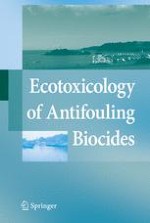2009 | OriginalPaper | Buchkapitel
Global Contamination by Organotin Compounds
verfasst von : Kurunthachalam Kannan, Shinsuke Tanabe
Erschienen in: Ecotoxicology of Antifouling Biocides
Verlag: Springer Japan
Aktivieren Sie unsere intelligente Suche, um passende Fachinhalte oder Patente zu finden.
Wählen Sie Textabschnitte aus um mit Künstlicher Intelligenz passenden Patente zu finden. powered by
Markieren Sie Textabschnitte, um KI-gestützt weitere passende Inhalte zu finden. powered by
Organotin compounds were first developed as moth-proofing agents in the 1920s, and were only later used more widely as bactericides and fungicides (WHO 1980). Organotin compounds produced for commercial applications include methyltins, butyltins, phenyltins, octyltins, and cyclohexyltins. The major uses of organotins are as polyvinyl chloride (PVC) heat stabilizers, catalysts (for silicone and poly-urethane production), biocides, agrochemicals, and glass coatings. The use of tributyltin (TBT) in marine antifouling paints dates from the 1960s, initially as a booster biocide in copper-based formulations. As a result of TBT's efficacy over copper, the use of TBT-based paints accelerated greatly in the 1970s. Annual production of organotin compounds increased from <5,000 t in 1955 to >50,000 t in 1995 (Fent 1996; OECD 2001), with 15–20% of the production accounted for by triorganotins (Bennett 1996). The global annual production of TBT alone was estimated to be 4,000 t in the late 1990s (OECD 2001). In addition to antifouling uses, TBT was used in wood and material preservatives, and slimicides. The use of TBT in antifouling paints applied to hulls of ships and boats, fish-nets, crab pots, docks, and water cooling towers contributed to the direct release of organotins into the aquatic environment. These antifouling usages have caused the greatest environmental concern, because of TBT's high aquatic toxicity. Since the widespread use of TBT-based paints began in the early 1970s, several researchers have reported the harmful effects of TBT on economically important marine food species such as oysters and mussels (for reviews, see Fent 1996; Champ and Seligman 1996 and other chapters in this volume).
One of the first documented instances of TBT toxicity was in Pacific oysters,
Crassostrea gigas
, in France's Arcachon Bay. Abnormal spatfall, decrease in larval survival rates, and shell malformations were observed as early as 1974. By the early 1980s, effects on oysters in Arcachon Bay had been linked to TBT, and in 1982 France banned the use of TBT-containing antifouling paints on vessels less than 25 m in length (Alzieu 1991). Many other countries adopted similar regulations from the late 1980s, e.g., the UK, the USA, Australia, Canada, The Netherlands, Switzerland, Japan, Denmark, and Hong Kong. The toxic effect of butyltins was also recognized in other bivalves, especially mussels, and in gastropods. Several studies in the 1980s established a link between TBT exposure and ‘imposex’ (the imposition of male sexual characteristics on females) in certain neogastropods, and the decline of populations in the waters off southwestern England (Smith 1981; Bryan et al. 1986). Imposex can be initiated in mollusks at water TBT concentrations in the low nanogram per liter range (i.e., <10 ng/l) (Bryan et al. 1986), also the concentration range at which shell deformities and larval mortalities occur (Alzieu 1991). In the mid 1980s, bioaccumulation of TBT in farmed salmon held in net-pens that had been treated with TBT-based antifouling paints was reported (Short and Thrower 1986; Davis and McKie 1987).
